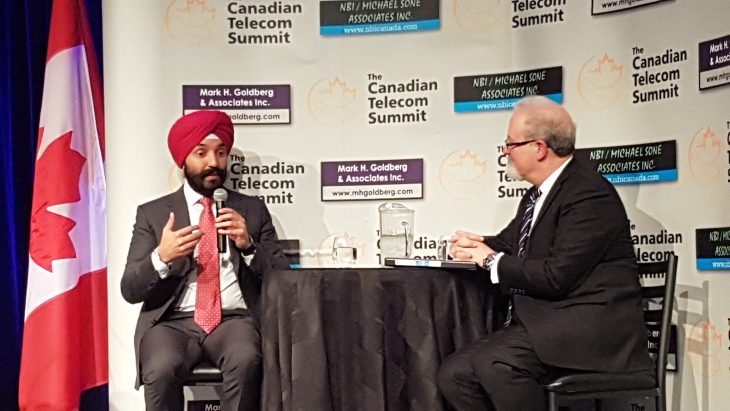
TORONTO – We’ve oft been in audiences covering dreary, news-free ministerial speeches. The Navdeep Bains keynote to the 2018 Canadian Telecom Summit today in Toronto was not that.
The Innovation, Science and Economic Development minister came with a crisp, fully loaded speech which satisfied some important needs for which many of the Canadian telecom gathering’s delegates have been clamoring (and he didn’t say “middle class families” once).
An issue which Summit co-founder Mark Goldberg and others have long been hounding various governments about has been the lack of a national, co-ordinated program to help connect low income families to the Internet. That changed today with Minister Bains’ announcement of the new Connecting Families program.
For $10 per month, participating ISPs will offer up to 220,000 low-income families an Internet package of 10 Mbps and a minimum of 100 GB of data usage each month, with no equipment or installation fees. Families must receive the maximum Child Care Benefit in order to qualify.
Bell, Cogeco, Rogers, SaskTel, Shaw, Telus, and Vidéotron are the original participants in the program at its launch. “We truly appreciate your efforts and collaborative spirit,” said Bains in his speech today.
ISED is also investing $13.2 million over five years (which was part of the 2017 budget) for the development of an online portal through Computers for Success Canada, which will see the distribution of 50,000 computers through Computers for Schools to families who need a computer and who qualify.
The Connecting Families initiative will go live in fall 2018 and in the meantime, ISED will work with other ISPs who want to be part of the program.
Applying for any job now requires Canadians to be online. Doing homework requires Canadian kids to be online. Many can’t afford the device or the connectivity and this program looks to fill that significant gap in bringing these folks into the digital economy. Large sums of money and several programs are available nationwide to connect rural regions but until today, there has been no co-ordinated national program to connect low income Canadians who may well be surrounded by broadband options, but can’t afford any of them.
Both Rogers and Telus, to their credit, already run low income broadband programs in parts of their wired footprints but until today, there was nothing which is national in scope – and good on ISED and the ISPs for getting this going. We’ve been hard on government in the past, so we’re pleased to see this plan now in place.
“It is imperative that we remember many Canadians are not fully engaged in the digital economy,” added Bains in the speech.
Rogers launched their program, called Connected For Success, back in 2013 with Toronto Community Housing and now has close to 200,000 customers spread out among several communities in its cable footprint.
Rogers announced today its 250th housing partner (including 100 co-ops). Its program offers high-speed internet access for $9.99/month, which includes up to 100 GB with speeds of up to 10 Mbps download and up to 1 Mbps upload. No contract or credit check is required upon sign up and it has partnerships with agencies to provide refurbished computers to customers.
Telus’ program, announced in 2016 and available in Alberta and B.C., is a pilot program called Internet for Good which offers qualifying households broadband for $9.95 per month for one year with speeds of up to 25 Mbps and up to 300 GB of data per month and access to a low cost refurbished computer, if required. The company worked in partnership with various community groups in the two provinces on this.
Spectrum for 5G
Bains also came with three different spectrum announcements, too.
He launched a consultation for the future spectrum auction related to the 3500 MHz band; an addendum consultation on proposing an additional 1 GHz of spectrum to the millimeter wave spectrum release; and said that the ministry has settled on its spectrum outlook out to 2022.
“We are proposing to release an additional 1 GHz of millimeter-wave spectrum and also launching a consultative process that will advance us toward the 3500 MHz auction,” he said in his speech. “As you know, the 3500 MHz spectrum is going to be one of the preferred bands for 5G services.
“The consultation reflects our commitment to get this spectrum into the marketplace in a timely way that also supports competition. We know that industry wants access to this spectrum.”
In fact, just yesterday, Telus CTO Ibrahim Gedeon urged the government to get on with auctioning 3.5GHz (as did other 5G proponents on Tuesday), so it would seem he got his wish.
“Our proposals align with international trends in the band and represent an important step toward ensuring 3500 will be available to meet consumer demand for 5G,” added Bains.
ISED also today released its spectrum road map for the next five years, noting there will be a spectrum auction in each of 2019 (600 MHz), 2020 (3.5GHz) and 2021 (the mm wave auction).
Bains also referenced the government’s $100 million commitment to low earth orbit satellite (Canadian companies Telesat, Kepler and Xplornet are working on this) which will also deliver broadband to those in faraway corners (or at least far enough away from the nearest wired network or wireless tower).
In all, a meaty, welcome, speech.
More to come.




